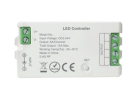
LED strip controllers are devices designed to control the operation of LED strips, allowing the user to change brightness, color, and lighting effect sequences. They provide the ability to create a variety of lighting scenarios, making them ideal for decorative and functional lighting in residential and commercial spaces.
There are several types of controllers, including infrared (IR), radio frequency (RF), Bluetooth, and Wi-Fi controllers. Each type has its own features and control methods: IR requires direct line of sight with the remote control, RF offers a greater coverage distance, and Bluetooth and Wi-Fi controllers allow lighting control through mobile apps.
Controllers can support various LED operation modes, including static colors, dynamic changes, transitions, flashing, and other effects. Models with dimming capabilities allow precise brightness level adjustment. Additionally, there are controllers that synchronize with music, changing the lighting in rhythm with the played melodies.
When choosing a controller, it is important to consider the power of the connected strip, the number of control channels, and the necessary compatibility with existing smart home systems. Modern controllers often support integration with voice assistants and smart home platforms, such as Amazon Alexa or Google Assistant, making them even more convenient to use.
Using LED strip controllers opens up wide possibilities for creativity in light design, allowing the creation of personalized and atmospheric solutions for any interior.
There are several types of controllers, including infrared (IR), radio frequency (RF), Bluetooth, and Wi-Fi controllers. Each type has its own features and control methods: IR requires direct line of sight with the remote control, RF offers a greater coverage distance, and Bluetooth and Wi-Fi controllers allow lighting control through mobile apps.
Controllers can support various LED operation modes, including static colors, dynamic changes, transitions, flashing, and other effects. Models with dimming capabilities allow precise brightness level adjustment. Additionally, there are controllers that synchronize with music, changing the lighting in rhythm with the played melodies.
When choosing a controller, it is important to consider the power of the connected strip, the number of control channels, and the necessary compatibility with existing smart home systems. Modern controllers often support integration with voice assistants and smart home platforms, such as Amazon Alexa or Google Assistant, making them even more convenient to use.
Using LED strip controllers opens up wide possibilities for creativity in light design, allowing the creation of personalized and atmospheric solutions for any interior.
There are no products to list in this category.
